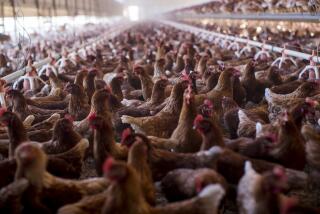Feed Ban Targets Mad Cow
WASHINGTON â In response to the threat of mad cow disease, the Food and Drug Administration on Tuesday proposed banning the use of certain potentially infectious cattle parts in animal feed, but it brushed aside other safety measures it had appeared to endorse last year.
The new rules, to take effect early next year, are expected to reduce the risk of infection by 90%, said Stephen F. Sundlof, director of the FDAâs Center for Veterinary Medicine.
Mad cow disease, technically bovine spongiform encephalopathy, or BSE, is believed to be caused by abnormal proteins, known as prions, found in brain and nerve tissue. Cattle can become infected if they eat feed contaminated with the infectious agent. Since 1997, the FDA has prohibited the use of animal parts in cattle feed.
The FDAâs new proposal bans the use of spinal cords and brains from cows 30 months of age or older and those that were not approved for human consumption in feeds marketed for poultry, pigs and pets. It does not include a ban on other so-called standard risk materials, or SRMs, such as cattle blood, poultry litter or restaurant plate waste. The FDA had appeared ready to ban those materials last year.
Cattle blood, often fed to calves as a milk replacer, and chicken manure mixed into cattle feed are both possible sources of BSE. The only way cattle are known to contract the disease is from eating feed containing cattle remains.
Critics of the proposal said the government was not âclosing all the gapsâ in the feed ban, as then-FDA Commissioner Lester Crawford had promised to do last month. Caroline Smith DeWaal, director of food safety at the Center for Science in the Public Interest, said that âwhen you dig down, it appears that they have put in a new definition of SRMs to apply to this rule. We could call it âSRM light.â â
Infection levels are believed to rise as cattle grow older, hence the 30-month age cutoff, but because there is no identification tracking system in the U.S., it becomes difficult to assess the exact ages, DeWaal said.
The original feed rule, first imposed in 1997 as a result of the mad cow outbreak in Britain, banned the uses of cattle parts only in cattle feed.
After the first U.S. case was found in 2003, the FDA began work to revise the rule.
The new proposal also does not include other cattle tissues, such as eyes or small intestines, considered standard risk materials by the Department of Agriculture.
âFeed regulations that are truly protective of animal and public health must incorporate a ban on all bovine SRMs in all animal feed and end the exemptions for blood, plate waste and poultry litter,â said Wenonah Hauter, director of the food program of Public Citizen, the nonprofit consumer advocacy group founded by Ralph Nader. âUntil these changes are made by FDA, consumers will remain at risk.â
Sundlof responded to the critics by saying that âfurther prohibitions on other materials just donât have a great effect on risk reduction and add a significant environment and monetary cost.â
Out of 400,000 cattle tested this year by the Department of Agriculture, only one cow was found to be BSE-positive, he added.
More to Read
Sign up for Essential California
The most important California stories and recommendations in your inbox every morning.
You may occasionally receive promotional content from the Los Angeles Times.










